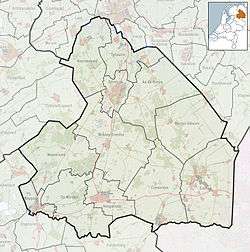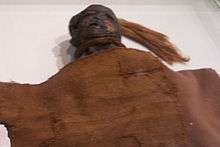Drents Museum
|
Drents Museum in 2005 | |
 Location in Drenthe in the Netherlands | |
| Established | 28 November 1854 |
|---|---|
| Location |
Brink 1 Assen, Netherlands |
| Coordinates | 52°59′35.88″N 6°33′51.84″E / 52.9933000°N 6.5644000°ECoordinates: 52°59′35.88″N 6°33′51.84″E / 52.9933000°N 6.5644000°E |
| Type |
Art museum History museum |
| Visitors | 227,000 (2013)[1] |
| Director | Harry Tupan[2] |
| President | Han Noten[2] |
| Curator | Wijnand van der Sanden[2] |
| Website |
www |
The Drents Museum (Dutch pronunciation: [ˈdrɛnts myˈzeːjɵm]) is an art and history museum in Assen in the province of Drenthe in the Netherlands. The museum was opened in 1854. It has a collection of prehistorical artifacts, applied art, and visual art. The museum also has temporary exhibitions. In 2013, it had 227,000 visitors.
History
The museum was founded by the King's Commissioner of Drenthe on November 28, 1854 as the Provincial Museum of Drents Antiquities.
On November 6, 2007, the museum announced that architect Erick van Egeraat was chosen to design a new extension for the museum. Total costs were estimated at eighteen million euro. From summer 2010 to summer 2011 the museum was closed. At the beginning of 2010, a new modern depot facility for approximately 90,000 objects and works of art was completed. The new wing was opened officially in November 2011.
The museum conducted a CT scan and endoscopy of a stature of Buddha that documented the presence of a mummy identified as that of a monk, Liuquan, a Buddhist master of the Chinese Medical School. The statue is reported to date to the eleventh or twelfth century. The mummy will be put on display at the Hungarian Natural History Museum through May 2015.[3][4]
Collection
The museum has a large permanent collection of prehistoric artifacts from the province of Drenthe. It includes exhibits of bog bodies such as the Yde Girl,[5] the Weerdinge Men,[6] Exloërmond Man, and the Emmer-Erscheidenveen Man.[7] There are finds from the Funnelbeaker culture, and the collection also includes the oldest recovered canoe in the world, the Pesse canoe, that dates between 8200 and 7600 BC.[8][9]
An annex building has period rooms demonstrating the lifestyle of well-to-do Drenthe families from various time periods. This building also houses ceramics pertaining to the House of Orange known as the collection Bontekoe. In the garden stands a statue of Bartje Bartels, the main character of books by Anne de Vries,[10] and a symbol of the province of Drenthe.
The museum holds a permanent collection of figurative art with particular attention to Realism from northern Europe and representatives of the fourth generation of Dutch Abstract figurative artists such as Henk Helmantel, Matthijs Röling, Sam Drukker, Douwe Elias, and Eddy Roos.
There also is a collection of art and applied art from 1885 to 1935 with work by Vincent van Gogh, Jan Eisenloeffel, Chris Lebeau, Jan Toorop, and Jan Sluijters.

 Offertory collection box
Offertory collection box Peat Boat with Two Figures (1883) by Vincent van Gogh
Peat Boat with Two Figures (1883) by Vincent van Gogh- Mother at the Linen Closet by Theo Molkenboer
Selected exhibitions
- Go China! was a joint exhibition between the Drents Museum and the Groningen Museum held from February 2 to August 31, 2008. The Terracotta Army was the central exhibit. With 353,000 visitors, it was the most successful exhibition ever in the northern Netherlands.[11] The Groninger Museum showed modern art from China with an emphasis on photography and installations made after 2000. In total, nearly 500,000 people visited the two exhibitions.[12]
- Eddy Roos - Verstilde beweging. A major retrospective of the work of Eddy Roos was held from September 27, 2009 to January 25, 2010. It contained approximately 200 drawings and 70 bronze sculptures (including 16 life-size) with extracts from his 42 dance films and live performances with professional dancers.
- Goud uit Georgie, de mythe van het Gulden Vlies[13] (Gold from Georgia, the myth of the Golden Fleece). An exhibition from March 6 to August 15, 2010, about grave findings from the bronze, iron, and Roman age in Georgia, among them golden objects from the temple city of Vani. Most of the exhibited objects are from the National museum in Tbilisi.
- In the autumn of 2011, the Drents Museum will open an exhibition on the Tang Dynasty, the Golden Age of China.
Administration
Annabelle Birnie has been the museum director since 2012.[2][14] Wijnand van der Sanden is the conservator.[2]
In 2013, the museum had 227,000 visitors.[1]
References
- 1 2 (in Dutch) "2013: Overzicht bezoekcijfers musea in Nederland", Metro, 2013. Retrieved on 20 July 2014.
- 1 2 3 4 5 (in Dutch) Organisatie, Drents Museum. Retrieved on 20 July 2014.
- ↑ Van Jaarsveldt, Janene, 1000-year-old Chinese Mummy Gets CT Scan in Amersfoort, NL Times, NL, December 9, 2014
- ↑ Jobson, Christopher, CT Scan of 1,000-Year-Old Buddha Statue Reveals Mummified Monk Hidden Inside, Colossal, February 21, 2015
- ↑ "Bog mummie: Yde Girl". Mummytombs.com. Archived from the original on 2010-03-30. Retrieved 2010-04-07.
- ↑ "Bog mummie: Weerdinge Men". Mummytombs.com. Archived from the original on 2010-04-02. Retrieved 2010-04-07.
- ↑ "Bog mummie: Emmer-Erscheidenveen Man". Mummytombs.com. Archived from the original on 2010-04-18. Retrieved 2010-04-07.
- ↑ Van Zeist, W. (1957), "De steentijd van Nederland", Nieuwe Drentse Volksalmanak, 75: 4–11
- ↑ "The Mysterious Bog People - Background to the exhibition". Canadian Museum of Civilization Corporation. 2001-07-05. Retrieved 2009-06-01.
- ↑ "Anne de Vries". Librarything.com. Retrieved 2010-04-07.
- ↑ "Terracottasoldaten trekken recordaantal bezoekers". Nieuws.nl. 31 August 2008.
- ↑ "Bijna half miljoen museumbezoekers zagen Go China!". Trouw.nl. 23 November 2008.
- ↑ "Goud uit Georgië - De mythe van het Gulden Vlies". Kunstbus.nl. Archived from the original on 2011-09-28. Retrieved 2010-04-07.
- ↑ (in Dutch) Marijke Brouwer, "Birnie gaat de ING-collectie achterna", Dagblad van het Noorden, 2012. Retrieved on 20 July 2014.
External links
| Wikimedia Commons has media related to Drents Museum. |
| Dutch Rijksmonument 469358 |